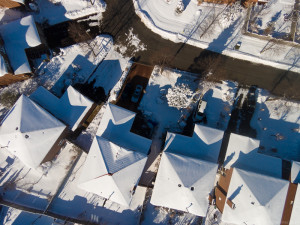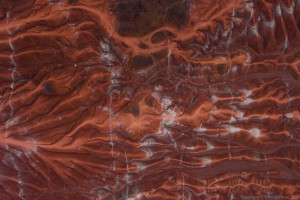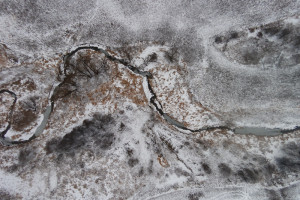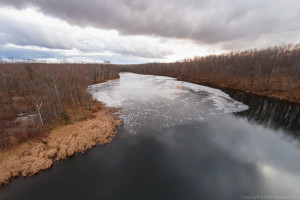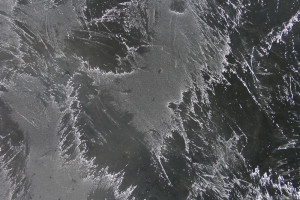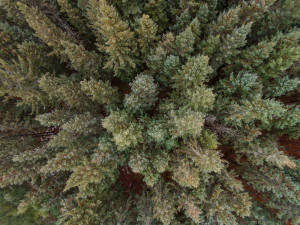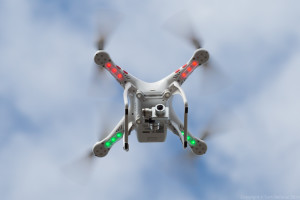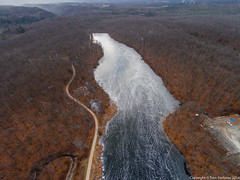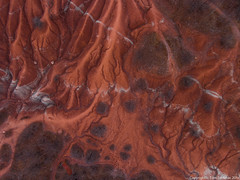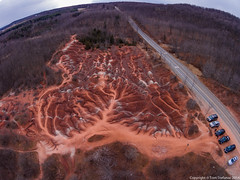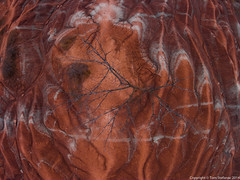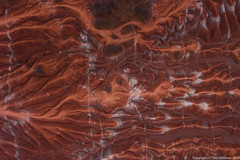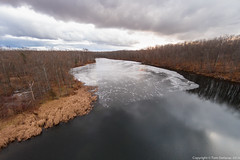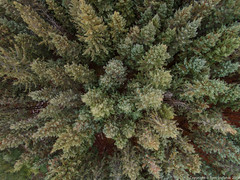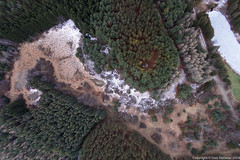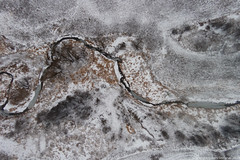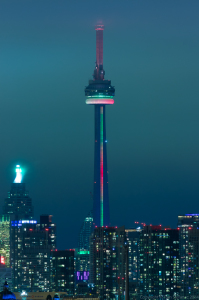A photo is worth a thousand words but how do you convey an abstract idea like the cold? Well it’s not easy, you could take a photo of something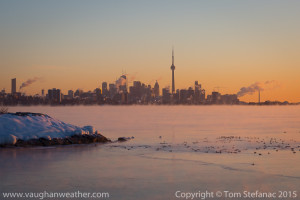 like a thermometer showing how cold it is but most photos of thermometers are boring. Now, if you had a thermometer covered in ice on what appears to be arctic tundra, well then, that’s a different story. Unfortunately ice laden thermometers and arctic tundra are often in short supply so we have to settle for other means. If you look at the photo to the right, it’s a shot of the Toronto skyline just after sunrise. It was around -23C when I took this photo and the winds were light. Needless to say, it was actually cold, but skylines on their own don’t necessarily convey that cold feeling. In order to achieve the cold look several things came together. Firstly, it was clearly sunrise in the photo and the viewer would understand that it was taken just after daybreak which is typically the coldest time. Secondly, the lake provided a natural steam covered foreground as it literally looked like it was boiling. Third, the rock outcropping to the left of the photo is ice-covered and lastly, you can see ice sheets covering the water’s surface closest to the point of the observer. Everything else, the tones in the sky, the smoke from the buildings and the ducks relaxing just help to enhance the message and convey the feeling of coldness. Capturing a photo like this requires that as a photographer you’re in the right place, at the right time, on the right day. It’s not hard, you just need to time and plan things correctly.
like a thermometer showing how cold it is but most photos of thermometers are boring. Now, if you had a thermometer covered in ice on what appears to be arctic tundra, well then, that’s a different story. Unfortunately ice laden thermometers and arctic tundra are often in short supply so we have to settle for other means. If you look at the photo to the right, it’s a shot of the Toronto skyline just after sunrise. It was around -23C when I took this photo and the winds were light. Needless to say, it was actually cold, but skylines on their own don’t necessarily convey that cold feeling. In order to achieve the cold look several things came together. Firstly, it was clearly sunrise in the photo and the viewer would understand that it was taken just after daybreak which is typically the coldest time. Secondly, the lake provided a natural steam covered foreground as it literally looked like it was boiling. Third, the rock outcropping to the left of the photo is ice-covered and lastly, you can see ice sheets covering the water’s surface closest to the point of the observer. Everything else, the tones in the sky, the smoke from the buildings and the ducks relaxing just help to enhance the message and convey the feeling of coldness. Capturing a photo like this requires that as a photographer you’re in the right place, at the right time, on the right day. It’s not hard, you just need to time and plan things correctly.
There are many other ways to convey coldness without needing a steaming lake. In the photo below to the left, there is really nothing special 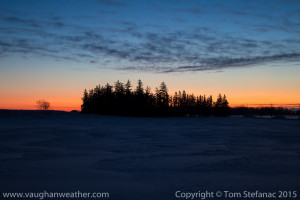 going on. No steam, no frozen lake, no smoke rising, yet it still looks very cold. Again, this photo was taken just before sunrise but for the observer this could be sunrise or sunset. It was around -22C when I snapped this near Stouffville. The overwhelming cool blue tones accented by the orange from the sunrise with the dark silhouette from the trees and snow covered foreground all just seem to scream cold. One thing I have found with cold photos is that you can fake them, but nothing seems to actually replace a photo taken on a truly cold or down right frigid day, unless of course, you remove the colour.
going on. No steam, no frozen lake, no smoke rising, yet it still looks very cold. Again, this photo was taken just before sunrise but for the observer this could be sunrise or sunset. It was around -22C when I snapped this near Stouffville. The overwhelming cool blue tones accented by the orange from the sunrise with the dark silhouette from the trees and snow covered foreground all just seem to scream cold. One thing I have found with cold photos is that you can fake them, but nothing seems to actually replace a photo taken on a truly cold or down right frigid day, unless of course, you remove the colour.
Subconsciously the human mind for some reason associates loneliness and desolation with cold. This photo of Woodbine beach to the right was taken on a cool -5C night which is not exactly cold by 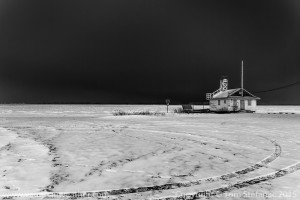 Canadian standards, but the fresh coating of snow, the lack of colour and dark tones in the sky gave it a desolate appearance. The lack of any other structures in the photo really make it feel like this is a lonely output on some barren landscape. So while physically it was not really that cold, the photo still manages to overwhelmingly convey that feeling. Now I will stress that while it does convey a cold feeling, a steaming lake or a photo taken on a really cold day seems to still convey that message more strongly.
Canadian standards, but the fresh coating of snow, the lack of colour and dark tones in the sky gave it a desolate appearance. The lack of any other structures in the photo really make it feel like this is a lonely output on some barren landscape. So while physically it was not really that cold, the photo still manages to overwhelmingly convey that feeling. Now I will stress that while it does convey a cold feeling, a steaming lake or a photo taken on a really cold day seems to still convey that message more strongly.
Here’s a great example of a frigging freezing day which looks warm! The fluffy snow, the bright 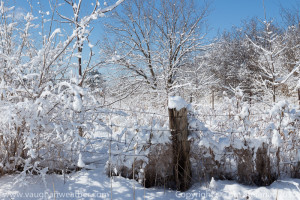 daylight, the “warm” blue sky, all the whites and the overall fluffy feel of the photo makes it feel or at least appear much warmer than it really is. When I took this photo I particularly remember thinking that I was going freeze &%^ my fingers off. There was a very light breeze but it was around -20C and I was trying to capture a snowy owl that was hidden from view in the nearby cluster of trees. So I was outside for a good 15 to 20 minutes just loosing body heat. I remember snapping this photo as part of a smaller series before giving up on the owl and heading home. You can see that it’s easy to convey different messages either intentionally or accidentally despite what the reality of the situation is depending on people’s reference points and the subject matter.
daylight, the “warm” blue sky, all the whites and the overall fluffy feel of the photo makes it feel or at least appear much warmer than it really is. When I took this photo I particularly remember thinking that I was going freeze &%^ my fingers off. There was a very light breeze but it was around -20C and I was trying to capture a snowy owl that was hidden from view in the nearby cluster of trees. So I was outside for a good 15 to 20 minutes just loosing body heat. I remember snapping this photo as part of a smaller series before giving up on the owl and heading home. You can see that it’s easy to convey different messages either intentionally or accidentally despite what the reality of the situation is depending on people’s reference points and the subject matter.
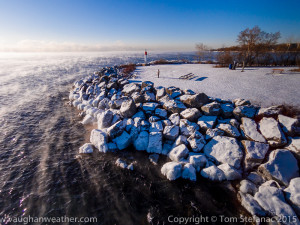 Sometimes though you can achieve more dramatic results through unique images that really reveal the environment. Here’s a photo I took from the foot of Humber Bay West Park with a small UAV flying out over the open waters of Lake Ontario. Fortunately, Lake Ontario does not really freeze and for the most part it remains open water even in the coldest of winters. On this day it was around -24C and the winds were blowing lightly from the north. The sun was still rising along the eastern horizon and the steam fog from the lake was also depositing ice along the bolder covered shoreline. It’s a photo that is unique and naturally feels cold. I took the close up image of the rocks below form the shoreline to capture some of the steam. I needed the contrast from the rocks to reveal it. This would be a more traditional photo, and while interesting it lacks the same power that the aerial image delivers just by virtue of the fact that it is more or less traditional and people have come to expect such images.
Sometimes though you can achieve more dramatic results through unique images that really reveal the environment. Here’s a photo I took from the foot of Humber Bay West Park with a small UAV flying out over the open waters of Lake Ontario. Fortunately, Lake Ontario does not really freeze and for the most part it remains open water even in the coldest of winters. On this day it was around -24C and the winds were blowing lightly from the north. The sun was still rising along the eastern horizon and the steam fog from the lake was also depositing ice along the bolder covered shoreline. It’s a photo that is unique and naturally feels cold. I took the close up image of the rocks below form the shoreline to capture some of the steam. I needed the contrast from the rocks to reveal it. This would be a more traditional photo, and while interesting it lacks the same power that the aerial image delivers just by virtue of the fact that it is more or less traditional and people have come to expect such images.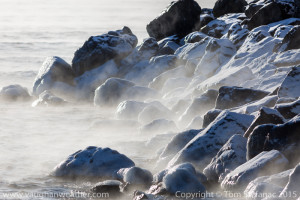 In fact I would argue that UAV based aerial images are the biggest thing to happen to photography in the last 30 years only to be outdone by the digital revolution itself. Sure, image stabilization came along, auto focus became quick and accurate and ultra-telephoto lenses got better but until now, photography and the standard SLR or DSLR have not really changed all that much. Digital photography brought us the ability to shoot almost unlimited images with instant, constant, predictable results and the freedom from being locked into a specific ISO or ASA. Film is a beautiful medium that really is different yet similar to digital photography, but at the end of the day, UAV’s have allowed cameras of any and all types to go places normally not possible and produce unseen perspectives.
In fact I would argue that UAV based aerial images are the biggest thing to happen to photography in the last 30 years only to be outdone by the digital revolution itself. Sure, image stabilization came along, auto focus became quick and accurate and ultra-telephoto lenses got better but until now, photography and the standard SLR or DSLR have not really changed all that much. Digital photography brought us the ability to shoot almost unlimited images with instant, constant, predictable results and the freedom from being locked into a specific ISO or ASA. Film is a beautiful medium that really is different yet similar to digital photography, but at the end of the day, UAV’s have allowed cameras of any and all types to go places normally not possible and produce unseen perspectives.
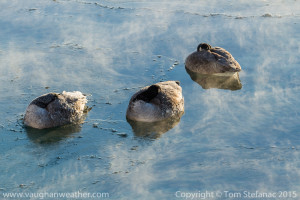 Now before I get too far off topic, let’s return to the concept of shooting the cold. As far as subject matter goes, animals are a great start. We’ve all seen photos of woolly looking cattle covered in snow during a blizzard or the warm foggy air created by their breathing hanging on a very cold day. These are the types of photos that link the physical cold to living creatures, things that actually feel and react to the environment in an immediately visible way. Here I’ve posted a photo of Canada Geese that were likely sleeping in the warm lake all night to avoid the bitterly cold air. Their feathers as a result are covered in ice crystals and they look visibly cold. But remember, you’re not just limited to images of birds or cows, humans make great subject matter too! The more layers, the better!
Now before I get too far off topic, let’s return to the concept of shooting the cold. As far as subject matter goes, animals are a great start. We’ve all seen photos of woolly looking cattle covered in snow during a blizzard or the warm foggy air created by their breathing hanging on a very cold day. These are the types of photos that link the physical cold to living creatures, things that actually feel and react to the environment in an immediately visible way. Here I’ve posted a photo of Canada Geese that were likely sleeping in the warm lake all night to avoid the bitterly cold air. Their feathers as a result are covered in ice crystals and they look visibly cold. But remember, you’re not just limited to images of birds or cows, humans make great subject matter too! The more layers, the better!
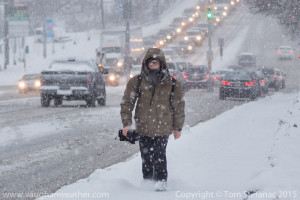 As an example here’s a man walking uphill during a cold snowy February day. He’s walking through about 15 centimeters of fluffy snow and marching along without gloves. Needless to say, it was not all that cold during this storm, but you’ll note his face is covered up and people’s eyes naturally gravitate to faces. As a result, the first thing most people will notice is that he’s bundled up and then realize that he’s not wearing gloves. It all comes together to form an interesting traditional winter photo. You know, the kind of photo that goes with the kind of story where your grandfather walked uphill both ways in 3 feet of snow with tattered shoes just to get to school and only suffered minor frost bite because that’s just how the world worked back then? Here’s another example of a really cold looking photo with some brave guy’s in a boat fishing. Fishing is great, I just prefer to do it while drinking a beer and getting a tan on a nice hot summer day!
As an example here’s a man walking uphill during a cold snowy February day. He’s walking through about 15 centimeters of fluffy snow and marching along without gloves. Needless to say, it was not all that cold during this storm, but you’ll note his face is covered up and people’s eyes naturally gravitate to faces. As a result, the first thing most people will notice is that he’s bundled up and then realize that he’s not wearing gloves. It all comes together to form an interesting traditional winter photo. You know, the kind of photo that goes with the kind of story where your grandfather walked uphill both ways in 3 feet of snow with tattered shoes just to get to school and only suffered minor frost bite because that’s just how the world worked back then? Here’s another example of a really cold looking photo with some brave guy’s in a boat fishing. Fishing is great, I just prefer to do it while drinking a beer and getting a tan on a nice hot summer day!
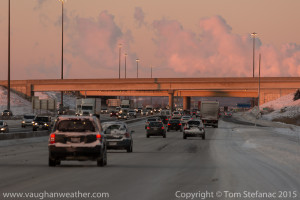 One area where I find photographers sometimes miss the cold is in the more traditional urban and suburban environments. Here’s a shot of highway 401 looking west with the rising sun to my back. This was a brutal day, there were accidents occurring every few seconds because the road was glazed with ice. It was also a bone chilling -20C at the time. If you look at this photo and have any knowledge of winter, you don’t need to be told it’s cold. The fact that the freeway is covered with ice, it’s sunrise and the smoke on the horizon is billowing, all screams cold. Plus, people can relate, if your only used to tropical weather then you’re very lucky, but for those of us who experience four seasons and know all about shivering half way to work while the car tries to warm up, this photo speaks volumes.
One area where I find photographers sometimes miss the cold is in the more traditional urban and suburban environments. Here’s a shot of highway 401 looking west with the rising sun to my back. This was a brutal day, there were accidents occurring every few seconds because the road was glazed with ice. It was also a bone chilling -20C at the time. If you look at this photo and have any knowledge of winter, you don’t need to be told it’s cold. The fact that the freeway is covered with ice, it’s sunrise and the smoke on the horizon is billowing, all screams cold. Plus, people can relate, if your only used to tropical weather then you’re very lucky, but for those of us who experience four seasons and know all about shivering half way to work while the car tries to warm up, this photo speaks volumes.
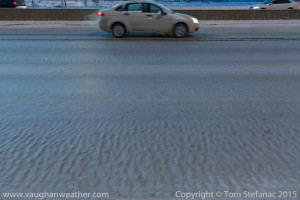 Here’s another shot from the same stretch of roadway. If you’re wondering why I’m stopped, it’s because there is a jacknifed tractor-trailer blocking three of the 4 available lanes behind me. The whole gallery is visible here within my spot news album on Flickr. This photos conveys the state of the roadway which was partly due to poor road maintenance, but greatly aggravated by extremely cold temperatures that were preventing the deicing solutions (salt in this case) from working properly.
Here’s another shot from the same stretch of roadway. If you’re wondering why I’m stopped, it’s because there is a jacknifed tractor-trailer blocking three of the 4 available lanes behind me. The whole gallery is visible here within my spot news album on Flickr. This photos conveys the state of the roadway which was partly due to poor road maintenance, but greatly aggravated by extremely cold temperatures that were preventing the deicing solutions (salt in this case) from working properly.
 As a photographer, remember that you don’t just have to take pictures because they’re pretty, always remember in many cases there is also some journalistic value and a deeper story. In this photo I was romping around Dufferin County because many of the local roads were closed and had actually been closed for several days. Believe me, I did not choose to go out looking solely for pretty winter photos, I was there because it was a blizzard and downright dangerous! High winds and very cold temperatures basically combined to created endless snow drifts that buried roads, stranded motorists and made all the above life-threatening. If interested, I do have a storm chase account here which goes through everything about the blizzard in great detail. In fact, from this little photojournalism adventure, I acquired some impressive news worthy photos that you would not achieve any other way. Not only do the photos convey how cold it was, but they also tell the story of the what was going on and how bad it really was.
As a photographer, remember that you don’t just have to take pictures because they’re pretty, always remember in many cases there is also some journalistic value and a deeper story. In this photo I was romping around Dufferin County because many of the local roads were closed and had actually been closed for several days. Believe me, I did not choose to go out looking solely for pretty winter photos, I was there because it was a blizzard and downright dangerous! High winds and very cold temperatures basically combined to created endless snow drifts that buried roads, stranded motorists and made all the above life-threatening. If interested, I do have a storm chase account here which goes through everything about the blizzard in great detail. In fact, from this little photojournalism adventure, I acquired some impressive news worthy photos that you would not achieve any other way. Not only do the photos convey how cold it was, but they also tell the story of the what was going on and how bad it really was.
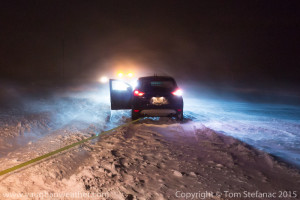 To that point, let me also include that the wind is always a great help to “lower” your photos temperature. The wind always makes the air feel cooler, so if you combine some wind, snow and cold air you will convey a much deeper effect through that imagery than you would otherwise. This photo was one of those “my bad” situations. I was driving along, going way too fast, caught a patch of ice, went sideways, corrected myself and just managed to catch a sliver of a plow windrow. This was enough to haul me deeper into the snow pile and firmly anchor me. Fortunately, my friend showed up and saved the day! I snapped this photo as he was pulling me out. I can’t remember exactly how cold it was at the time but it was around -25C and the wind was steady at 50-60 km/h lofting the loose snow everywhere. It was actually impossible to stand outside for any length of time without freezing or having your face suffer frost nip. The real world windchill would have been -43C meaning there was a high risk for frost bite occurring in 5-10 minutes and frost nip almost instantly. Now that I think about it, this photo does not actually convey how cold it really was but it still says “very cold” no matter how you look at it!
To that point, let me also include that the wind is always a great help to “lower” your photos temperature. The wind always makes the air feel cooler, so if you combine some wind, snow and cold air you will convey a much deeper effect through that imagery than you would otherwise. This photo was one of those “my bad” situations. I was driving along, going way too fast, caught a patch of ice, went sideways, corrected myself and just managed to catch a sliver of a plow windrow. This was enough to haul me deeper into the snow pile and firmly anchor me. Fortunately, my friend showed up and saved the day! I snapped this photo as he was pulling me out. I can’t remember exactly how cold it was at the time but it was around -25C and the wind was steady at 50-60 km/h lofting the loose snow everywhere. It was actually impossible to stand outside for any length of time without freezing or having your face suffer frost nip. The real world windchill would have been -43C meaning there was a high risk for frost bite occurring in 5-10 minutes and frost nip almost instantly. Now that I think about it, this photo does not actually convey how cold it really was but it still says “very cold” no matter how you look at it!
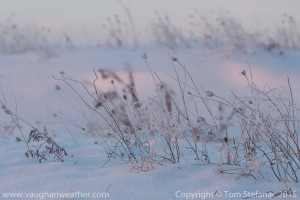 So remember these key concepts for your cold weather photos. First, a cooler or more blue white balance always makes a picture look colder than warm oranges and reds. Second, photos taken at midday always have too much sunlight, dusk, dawn, pre-dawn and early morning or late afternoon are the best times to achieve your coldest looking photos. Third, use your subject matter in a creative sense, look for ice, steam/fog/smoke, animals and people who look cold or anything else that physically binds the air temperature to an immediate and visible effect on the environment. Fourth, isolation, desolation and loneliness all convey a cold feeling to the human mind, especially if it is clearly winter in the scene. Fifth, if possible, look for unique angles and if available, use unique tools such UAV’s, graduated ND’s, long exposures on the order of 1-3 seconds to blur steam/fog and take your time to get those photos that are not immediately visible or easy. Sixth and last, remember that you’re not going out just for pretty photos, think about the journalistic side of things, why go to a regular park on a cold day if there’s a big broken watermain up the road flooding the neighborhood and encasing everything in ice or a water treatment plant with frozen bursting pipes. The park may be pretty but the news stories can be made pretty with a “wow” factor because your showing cause and effect in one photo. Hopefully these tips will help you with your future photographic journeys.
So remember these key concepts for your cold weather photos. First, a cooler or more blue white balance always makes a picture look colder than warm oranges and reds. Second, photos taken at midday always have too much sunlight, dusk, dawn, pre-dawn and early morning or late afternoon are the best times to achieve your coldest looking photos. Third, use your subject matter in a creative sense, look for ice, steam/fog/smoke, animals and people who look cold or anything else that physically binds the air temperature to an immediate and visible effect on the environment. Fourth, isolation, desolation and loneliness all convey a cold feeling to the human mind, especially if it is clearly winter in the scene. Fifth, if possible, look for unique angles and if available, use unique tools such UAV’s, graduated ND’s, long exposures on the order of 1-3 seconds to blur steam/fog and take your time to get those photos that are not immediately visible or easy. Sixth and last, remember that you’re not going out just for pretty photos, think about the journalistic side of things, why go to a regular park on a cold day if there’s a big broken watermain up the road flooding the neighborhood and encasing everything in ice or a water treatment plant with frozen bursting pipes. The park may be pretty but the news stories can be made pretty with a “wow” factor because your showing cause and effect in one photo. Hopefully these tips will help you with your future photographic journeys.
